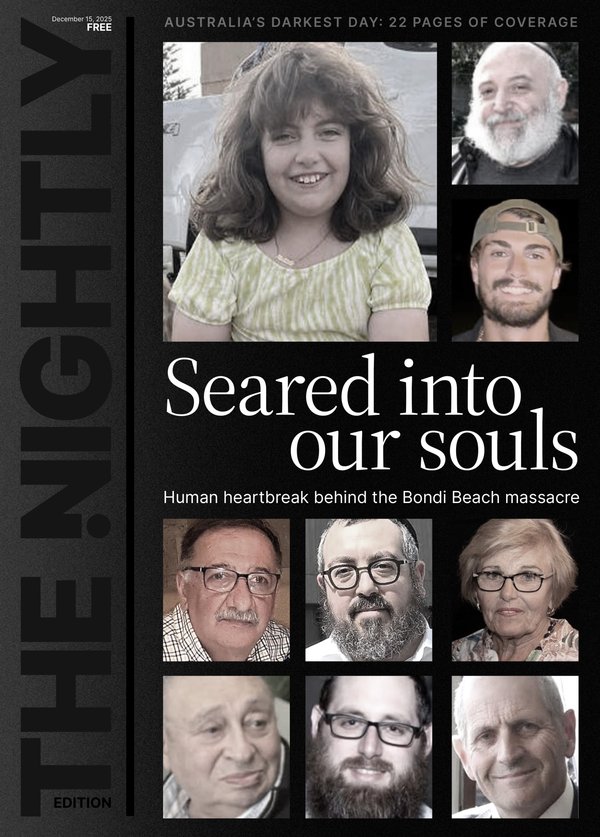Dick Cheney: Powerful Vice President and Washington insider, dies at 84
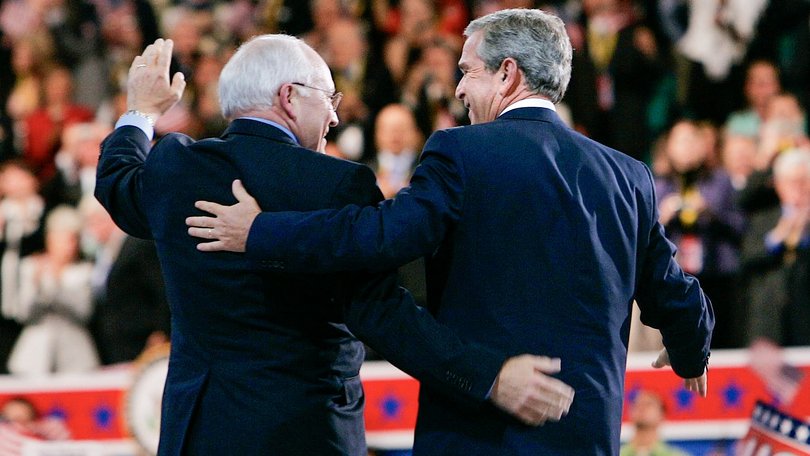
Dick Cheney, widely regarded as the most powerful vice president in US history, who was George W. Bush’s running mate in two successful campaigns for the presidency and his most influential White House adviser in an era of terrorism, war and economic change, died Monday. He was 84.
The cause was complications of pneumonia and cardiac and vascular disease, according to a statement from his family.
Plagued by coronary problems nearly all his adult life, Mr Cheney had five heart attacks from 1978 to 2010 and had worn a device to regulate his heartbeat since 2001. But his health issues did not seem to impair his performance as vice president. In 2012, three years after retiring, he underwent a successful heart transplant and had been reasonably active since then.
Sign up to The Nightly's newsletters.
Get the first look at the digital newspaper, curated daily stories and breaking headlines delivered to your inbox.
By continuing you agree to our Terms and Privacy Policy.Most recently, he startled Americans of both parties by announcing that he would vote for Vice President Kamala Harris, a Democrat, in the 2024 election, denouncing her Republican opponent, Donald Trump, as unfit for the Oval Office and a grave threat to US democracy.
“We have a duty to put country above partisanship to defend our Constitution,” Mr Cheney said.
His announcement echoed that of an earlier one by his daughter Liz Cheney, the former Republican representative from Wyoming, who broke with Mr Trump after the January 6, 2021, attack on the Capitol by his followers. She, too, said she would vote for Ms Harris.
As vice presidents go, Mr Cheney was a singular figure: more powerful and less ambitious for higher office than any vice president in modern times. A 10-year member of the House of Representatives, the youngest White House chief of staff in history, the defence secretary from 1989-93, a confidant of presidents and lawmakers, Mr Cheney had impeccable credentials and contacts and was a master in the art of getting things done, preferably without fanfare.
In many ways an inscrutable personality, he had no patience for small talk, almost never spoke about himself and rarely gave interviews or held news conferences, although he sometimes went on television to promote administration policies and was often in the news. He preferred the backstage to the spotlight.
A consummate Washington insider, Mr Cheney was an architect and executor of Mr Bush’s major initiatives: deploying military power to advance, they said, the cause of democracy abroad, championing free markets and deregulation at home, and strengthening the powers of a presidency that, as both men saw it, had been unjustifiably restrained by Congress and the courts in the aftermath of the Vietnam War and the Watergate scandal.
As Mr Bush’s most trusted and valued counsellor, Mr Cheney foraged at will over fields of international and domestic policy. Like a super-Cabinet official with an unlimited portfolio, he used his authority to make the case for war, propose or kill legislation, recommend Supreme Court candidates, tip the balance for a tax cut, promote the interests of allies and parry opponents.
But it was the national security arena where he had the most profound impact. As defence secretary, he helped engineer the Gulf War that successfully evicted Iraqi invaders from Kuwait in 1991, and then took a leading role a decade later in responding to the terrorist attacks of September 11, 2001. To prevent future attacks, he advocated aggressive policies including warrantless surveillance, indefinite detention and brutal interrogation tactics. And he pushed for the invasion of Iraq to topple Saddam Hussein in 2003, completing the unfinished job of his previous stint in power but leading to years of warfare.
Early in Mr Bush’s first term, many Democrats and even some fellow Republicans wondered if Mr Cheney might be the real power in a White House occupied by an untested president whose qualifications had been questioned. While Mr Bush eventually asserted his authority and Mr Cheney’s influence declined by the second term, the image of him as a Machiavellian paterfamilias was never quite dispelled.
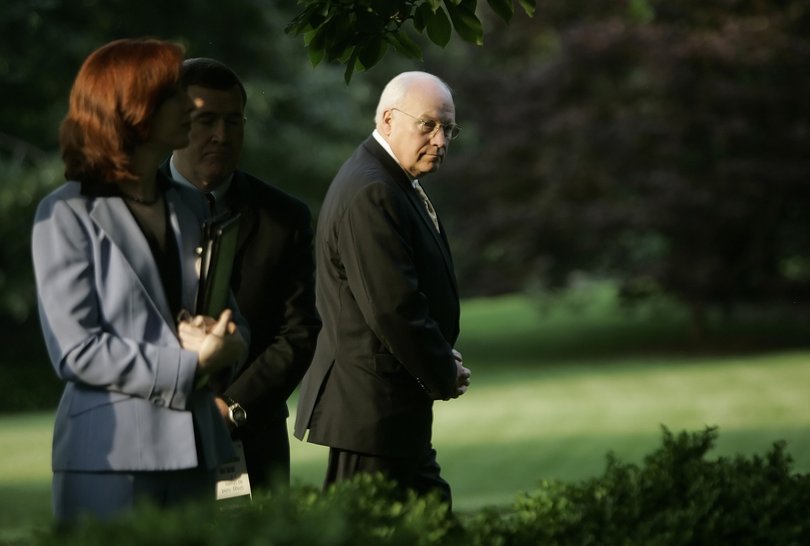
Even Mr Bush worried about that perception, as he noted in his 2010 memoir, “Decision Points.” He wrote that Mr Cheney offered to withdraw from the ticket for the 2004 presidential election, having become “the Darth Vader of the administration.” Mr Bush considered the offer, aware that accepting it “would be one way to demonstrate that I was in charge.” But he ultimately kept his running mate, saying he valued the vice president’s steadiness and friendship.
There was no question about Mr Cheney’s steadiness.
On Sept. 11, 2001, when hijacked airliners destroyed the World Trade Center in New York and crashed into the Pentagon and into a Pennsylvania field, killing nearly 3,000 people in the nation’s worst terrorist attack, it was Mr Cheney who took charge at the White House.
Mr Bush, who was visiting a school in Florida as the attacks took place, was shuttled to secure locations in Louisiana and Nebraska. The vice president activated defence measures across the nation, put US forces on alert around the world and ordered the Capitol evacuated and government leaders removed to safety. From a White House bunker, he maintained continuous contact with the president and other officials and kept what many called a steady hand at the helm through the crisis.
In the aftermath, Mr Cheney became the strategist behind a rapid expansion of presidential power to fight terrorism and a forceful proponent of Mr Bush’s doctrinal warning to the world: that nations and regimes would be counted as for or against the United States in the new age of terrorism, and that preemptive military action would be taken against anyone who posed a threat to the security of the country.
A Wartime Leader
Six weeks after the attacks, Mr Cheney helped engineer a swift, lopsided passage of the USA Patriot Act, a sweeping law that greatly expanded the government’s powers of investigation, surveillance and detention to fight terrorism. With the wounded nation still seething over September 11, public opposition to the law was muted, though civil libertarians warned that it authorised the government to spy on ordinary Americans.
Later, it became clear that the act was being used to underpin secret courts, wiretaps without warrants, the unlimited detention of suspects without hearings or charges, and interrogation methods that skirted bans on torture in the Geneva Conventions. There were wide protests and even constitutional challenges. But Mr Cheney strongly defended the law and its expansion of presidential power, and it remained in force.
Mr Cheney also strongly influenced Mr Bush’s decision to invade Afghanistan to hunt for Osama bin Laden, the leader of al-Qaida who masterminded the September 11 attacks, and to suppress a fanatical Taliban regime that had sheltered terrorists and imposed a brutal theocracy on the Afghan people.
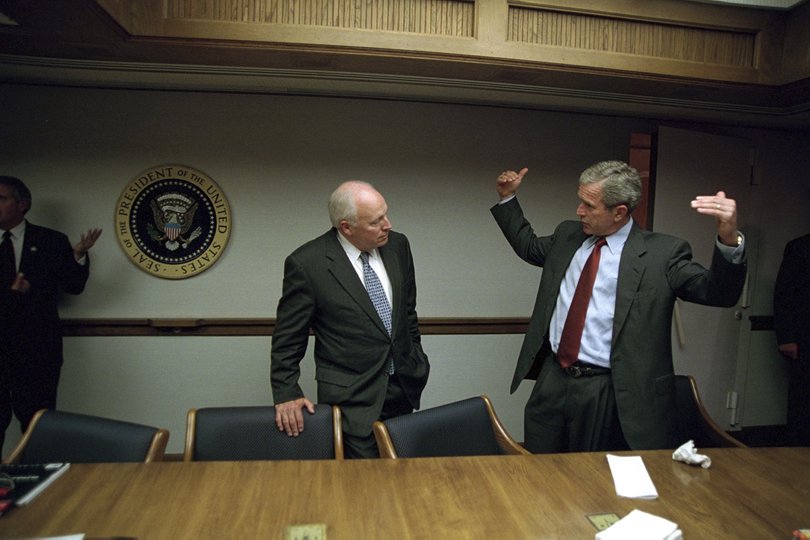
And it was Mr Cheney who was a dominant voice behind Mr Bush’s decision to invade Iraq in 2003 and then to try to justify the war. He insisted that Iraq’s president, Saddam, had ties to al-Qaida terrorists, possessed weapons of mass destruction and would threaten the US and its allies with nuclear blackmail.
What began as a one-month combat operation in Iraq gave way to a nearly nine-year occupation, a struggle against Iraqi insurgents and internecine warfare that would claim nearly 4,500 American and well more than 100,000 Iraqi lives (estimates vary), cost more than $US2 trillion, according to some reports, and leave a staggering trail of destruction throughout the country.
As the war dragged on, the outlines of an enormous intelligence failure began to emerge. The September 11 commission, an independent panel given the task of investigating the 2001 attacks, found no evidence of collaboration between Iraq and al-Qaida, and the chief weapons inspector of the CIA, a White House appointee, concluded that Iraq had no stockpiles of biological, chemical or nuclear weapons.
But these findings were released as Mr Bush and Mr Cheney campaigned for reelection in 2004, and the candidates conceded nothing. “To delay, defer, wait wasn’t an option,” Mr Cheney said. “The president did exactly the right thing.”
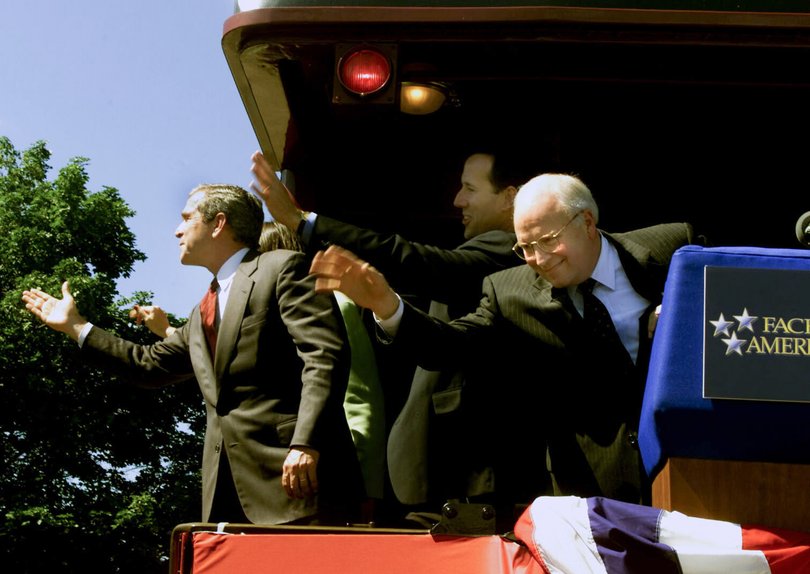
Defending a Legacy
During the 2008 presidential race, the Democratic nominee, Senator Barack Obama of Illinois, castigated the administration over the Iraq War. The Republican nominee, Senator John McCain of Arizona, who often used the shorthand “al-Qaida” to refer to a protean and increasingly divided enemy, warned against a premature troop withdrawal from Iraq, but rarely mentioned Mr Bush or Mr Cheney, distancing himself from a team whose day was nearly over.
After an almost two-year campaign, Mr Obama’s election presaged broad changes in foreign and domestic policy. And the Iraq War was hardly the only leftover problem.
In Afghanistan, a resurgent Taliban posed new dangers. Bin Laden’s terrorist network had been rebuilt in tribal strongholds of Pakistan. US alliances were frayed. Disputes with Iran, North Korea, Russia and other potential adversaries lingered. And the US and global economies were in deep distress, a result, many experts said, of Republican policies.
A month before leaving office, Mr Cheney struck an unapologetic tone in exit interviews, defending the use of broad executive powers in waging war, in the treatment of terrorism suspects and in domestic wiretapping, insisting that historians would ultimately look favourably on the administration’s efforts to keep the nation safe.
On January 20, 2009, Mr Cheney, who had hurt his back moving boxes and attended the inauguration at the Capitol in a wheelchair, was succeeded by Senator Joe Biden of Delaware. The two had been lobbing verbal grenades at each other for months. Mr Biden had called Mr Cheney “probably the most dangerous vice president we’ve had in American history” and vowed to “restore the balance” to the office. Mr Cheney fired back: “If he wants to diminish the office of vice president, that’s obviously his call.”
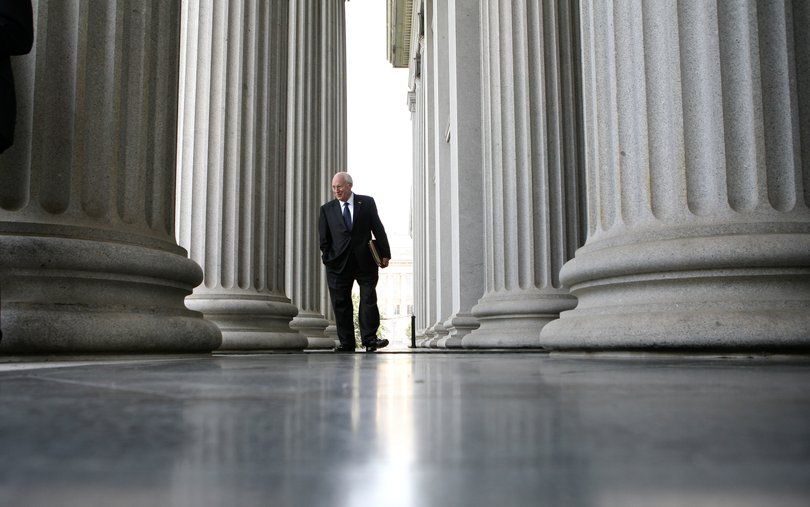
As Mr Obama took over, Mr Cheney broke with a long-standing practice of becoming inconspicuous after leaving office. He contended that the new president was endangering the country by planning to close the detention camp at Guantánamo Bay in Cuba, suspending military trials for terrorism suspects and prohibiting interrogation techniques like waterboarding.
In a blitz of television appearances and speeches, Mr Cheney soon emerged as the leading Republican critic of the new administration. No one envisioned that he would run again for elective office, but with his tenacity and insider’s knowledge of government and politics, he seemed to be mounting more than a rearguard defence of Mr Bush policies; rather, the aim, it appeared, was to influence the continuing national security debate as well as his own legacy. By then, he had joined a parade of Bush associates working on memoirs.
His book In My Time: A Personal and Political Memoir (2011, with Liz Cheney) expressed few regrets over the most controversial decisions of the Bush administration. While defending its actions, the book sidestepped many important questions in discussing the debates that had ensued over its policies, some reviewers said.
By 2014, five years after leaving the White House, Mr Cheney’s command of public attention seemed undiminished. Far from fading into the background of history, he thrust himself into national debates with an onslaught of more broadcasts and published commentaries assailing Mr Obama’s responses to Islamic militants in Iraq and Syria. He also went to Capitol Hill to urge Republicans to reject a rising isolationism in their party and embrace strong military and foreign policies.
And when the Senate Intelligence Committee accused the CIA of torturing terrorism suspects during the Bush years, Mr Cheney rose to defend the agency, arguing that its interrogations had been legally authorised and “absolutely, totally justified.” He roundly dismissed allegations that the CIA had misled the White House about its methods or inflated the value of the information obtained from prisoners.

Tensions in the White House
Several years before Mr Bush and Mr Cheney left office, evidence that there had been no weapons of mass destruction in Iraq was overwhelming, and even Mr Cheney abandoned the claim. But debate over the administration’s justification for waging war never went away, with the focus turning to the vice president’s office in the fall of 2005, when Mr Cheney’s chief of staff, I. Lewis “Scooter” Libby, was indicted on charges of perjury and obstruction of justice.
The charges were filed by a special prosecutor investigating the illegal disclosure of the identity of a covert CIA operative, Valerie Plame Wilson, whose husband, Joe Wilson, a former diplomat, had gone to Niger to investigate a report that Iraq had bought weapons-grade uranium there in 1999. Mr Wilson had found no evidence to support the story and had written an opinion article for The New York Times undermining the administration’s rationale for invading Iraq.
The significance of the case lay not in the disclosure of an agent’s identity, but in what seemed to lay behind it: a plan orchestrated by the White House to discredit Mr Wilson after his article was published by portraying his trip as a boondoggle that had been set up by his wife.
Mr Libby, who resigned, was not accused of leaking Valerie Plame Wilson’s name but of lying to a grand jury and federal agents when he told them that he had learned her identity from a reporter. The indictment said he had actually learned it from administration officials. It cited Cheney in three passages and, while it did not accuse him of wrongdoing, it strongly suggested that he had been behind the campaign to discredit Wilson.
At Mr Libby’s trial in early 2007, his lawyers argued that he had not lied, but had only misspoken. Neither Mr Libby nor Mr Cheney testified. But prosecution witnesses swore that Mr Libby had learned of Wilson’s identity from officials, and he was found guilty, becoming the highest-ranking White House official convicted of a felony since the Iran-Contra scandals of the 1980s.
Mr Libby was sentenced to 30 months in prison, a $US250,000 fine and two years’ probation. Mr Bush commuted the prison term but did not grant a pardon, leaving the fine and probation in place. The president portrayed the commutation as a compromise, but his action reignited passions in the case. Critics called it a subversion of justice to keep Mr Libby from disclosing White House war planning. Mr Libby’s supporters said his resignation and humiliation had been punishment enough.
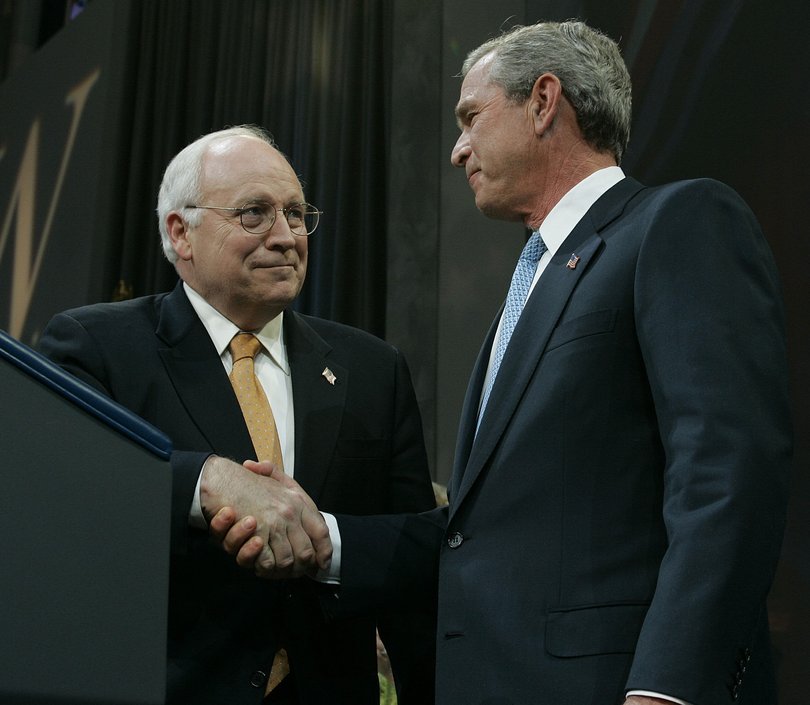
The case had a corrosive effect on Mr Cheney’s political stature, creating a rift between the president and the vice president, which both acknowledged after leaving office, though the White House initially denied it, saying Mr Cheney was still Mr Bush’s closest adviser. But even then, some Republican aides acknowledged that the president had been upset, and that Mr Cheney had become less of an avuncular mentor to him.
Mr Bush, in his memoir, said Mr Cheney had lashed out at him in their final days in office for his refusal to grant Mr Libby a presidential pardon. “I can’t believe you’re going to leave a soldier on the battlefield,” Mr Cheney told him heatedly, according to Mr Bush. The former president wrote: “The comment stung. In eight years, I had never seen Dick like this, or even close to this.”
In 2018, Mr Trump granted a full pardon to Mr Libby. “I don’t know Mr Libby,” Mr Trump said, “but for years I have heard that he has been treated unfairly.” The pardon amounted to a dramatic coda to a case that had once gripped Washington and came to embody divisions over the Iraq War.
Mr Cheney issued a public statement thanking Mr Trump for the pardon, but it was a rare grace note in an otherwise rocky relationship with the president.
Trump and Cheney’s rocky relationship
Months after the pardon, Mr Cheney, visiting Mexico, said Mr Trump had been “wrong” during his presidential campaign to say that Mexican immigrants were “bringing drugs, they’re bringing crime, they’re rapists.”
In another slap at candidate Mr Trump, Mr Cheney spoke out against his proposal to ban Muslims from entering the United States. “I think this whole notion that somehow we can just say no more Muslims, just ban a whole religion, goes against everything we stand for and believe in,” Mr Cheney said.
And in 2019, Mr Cheney, in an off-the-record exchange with Vice President Mike Pence at an American Enterprise Institute forum, complained of Mr Trump’s use of Twitter diplomacy, which was often done without consulting aides or the intelligence community. Mr Cheney warned that the United States was “getting into a situation when our friends and allies around the world that we depend upon are going to lack confidence in us.”
Donald Trump Jr., a close adviser to his father, hit back. “Isn’t it fitting,” he said, “that Cheney is the one mad that Trump is ending his reckless and endless wars? I never knew peace could be so unpopular.”
In the first term of Bush-Cheney, their days often began together in the Oval Office with a review of the agenda. Mr Cheney was there when Mr Bush saw Cabinet officials, took policy briefings and met foreign leaders. But in the second term, Mr Cheney increasingly lost influence to Condoleezza Rice, the secretary of state, and Stephen Hadley, the national security adviser.
Mr Cheney had lost allies. Rumsfeld and Libby were gone, and others had resigned: Paul Wolfowitz, the deputy defense secretary, and Douglas Feith, the undersecretary of defense. Mr Cheney was virtually the last of the inner circle.
Mr Bush had also grown less reliant on him. On Capitol Hill, where he had easily had his way in the first term, Mr Cheney faced strained relationships, even with old allies. In retrospect, White House aides said, the vice president’s power appeared to have peaked in 2003 and 2004.
But he was still the point man on national security in his second term.
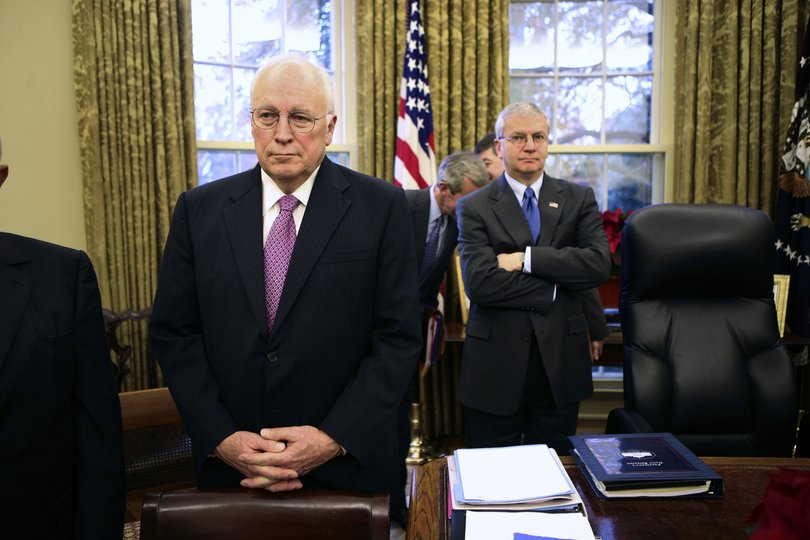
He defended the handling of prisoners at Guantánamo Bay, dismissing reports that detainees, who were held for years without charges or trials, had been tortured or abused. He said they were well fed, well treated and “living in the tropics,” adding, “They’ve got everything they could possibly want.”
After the Times disclosed in December 2005 that Mr Bush had for years authorised the National Security Agency to eavesdrop without warrants on Americans and others in the United States, the Justice Department investigated what it called a leak of classified information. Mr Cheney said the Times had jeopardised national security.
In Congress, Mr Cheney defended domestic spying against charges that it might be unconstitutional and in violation of the 1978 Foreign Intelligence Surveillance Act, which governs intelligence gathering in the United States. Not only was it legal, but it had also worked, Mr Cheney contended, noting that there had been no terrorist attacks in the U.S. since 2001.
Over Cheney’s objections, the Senate adopted a proposal by Mr McCain, once a prisoner of war in Vietnam, to ban “cruel, inhuman and degrading” treatment of detainees. Outrage over Abu Ghraib, the Iraqi prison where naked prisoners had been photographed stacked in human pyramids and cowering before dogs, and reports of other abuses had led to bipartisan pressure for the ban.
In June 2006, the US Supreme Court handed the administration another setback, ruling that it had violated the Geneva Conventions and US law by creating military commissions to try terrorism suspects at Guantánamo Bay without judicial process. The court said Congress had not authorised such tribunals. Critics of the Bush-Cheney drive to expand presidential powers hailed the ruling.
But within months, Congress, still controlled by Republicans, gave the administration a comeback victory, passing legislation shaped by Mr Cheney that authorised the military commissions, renewed Bush’s power to designate detainees “unlawful enemy combatants” and allowed the government to imprison, interrogate and try them without judicial review indefinitely.
Architect of Foreign Policy
Mr Cheney was candid about his efforts to strengthen the powers of the presidency, which he said had been unduly eroded by Congress in the years after the Vietnam War and the Watergate scandal that drove President Richard Nixon out of the White House. The age of terrorism warranted broad executive powers, he told reporters aboard Air Force Two on a trip to the Iraq war zone in 2005.
“I believe in a strong, robust executive authority, and I think that the world we live in demands it,” Mr Cheney said. “I do believe that, especially in the day and age we live in, the nature of the threats we face, the president of the United States needs to have his constitutional powers unimpaired, if you will, in terms of the conduct of national security.”
Mr Bush’s decision to invade Iraq was the paradigm of Mr Cheney’s foreign policy influence, as his aggressive stance prevailed over the protracted caution of Mr Bush’s first secretary of state, Colin Powell. In the spring of 2002, a year before the war, Mr Cheney went to Britain and the Middle East to enlist allies. He did not secure Arab support, but Britain became the United States’ closest ally.
And it was Mr Cheney, in a speech to the Veterans of Foreign Wars National Convention in Nashville, Tennessee, on Aug. 26, 2002, who enunciated the rationale for war. Citing unnamed intelligence sources, he said Iraq already had biological and chemical weapons and would “fairly soon” have nuclear weapons.
“Simply stated, there is no doubt that Saddam Hussein now has weapons of mass destruction,” Mr Cheney said. “There is no doubt he is amassing them to use against our friends, against our allies and against us.”
White House officials said Mr Cheney had mirrored Mr Bush’s views. The talk alarmed US allies, but it laid the groundwork for the invasion seven months later.
Mr Cheney was portrayed in Mr Bush’s memoir as a steamrollering force for military intervention in Iraq. He wrote that his vice president “had gotten out in front of my position” in his Nashville speech, when he simply dismissed the prospect of further weapons inspections.
Mr Cheney, who travelled to more than 30 countries to promote the administration’s policies, also adopted hard lines against Iran and North Korea, whose nuclear ambitions prompted Mr Bush early in his presidency to label them, along with Iraq, as an “axis of evil.” But in his last year in office, Mr Bush made concessions to Iran and North Korea, siding with Mr Rice, not Mr Cheney, resolving the administration’s internal tugs of war but not the nuclear perils.

In 2006, North Korea tested a nuclear weapon, but in 2007 it agreed to disable its nuclear facilities in exchange for $400 million in fuel oil and aid from South Korea, China and the United States. Mr Rice finessed the deal, circumventing Mr Cheney, who, after years of shunning North Korea, said it amounted to rewarding a miscreant.
North Korea began dismantling its reactor, but amid disagreements over inspections, the deal seemed about to collapse until Mr Bush, late in 2008, removed North Korea from a blacklist of state sponsors of terrorism in exchange for inspections “based on mutual consent” to verify a nuclear shutdown. Critics voiced doubts that the arrangement would work, and it didn’t. North Korea remained a nuclear peril.
Iran said its uranium-enrichment program had peaceful aims. A 2007 National Intelligence Estimate said that Iran had halted its nuclear weapons program in 2003 but that it had continued to enrich uranium. International sanctions and warnings of military action reflected widespread scepticism over Iran’s intentions. The Bush administration finally agreed to talks, but there were no breakthroughs, and North Korea did go on to successfully develop nuclear weapons.
Driving a Domestic Agenda
On domestic matters, Mr Cheney was a strong advocate for Mr Bush’s Supreme Court nominees: John Roberts as chief justice in 2005, and Samuel Alito in 2006 (though Cheney had originally urged the president to pick federal Judge J. Michael Luttig rather than Roberts). Steve Schmidt, a senior Cheney adviser, rode herd on the Senate confirmations, and the court moved further toward the conservative end of the political spectrum.
Mr Cheney was also a forceful exponent of Bush’s economic plans and tax cuts, which favoured businesses and the wealthy, and he pushed energy and environmental policies that opened federal lands to oil, gas and mining exploitation.
On Capitol Hill, especially in the first term, Mr Cheney was the administration’s chief ambassador and enforcer. Republican lawmakers and even many Democrats regarded him as Bush’s surrogate and a member of their club, a wily horse-trader who knew the game, the odds and all of the players. He often played a critical role, forging compromises and, as president of the Senate, sometimes casting deciding votes.
Mr Cheney’s views on taxes were, in a historical way, quite radical. He favoured a flat tax or a national sales tax to replace progressive income taxes that had put the heaviest burdens on the rich since President Woodrow Wilson’s time. No such taxes were adopted.
But the administration, arguing that taxation stifles investment, won cuts to income and estate taxes in 2001 and to capital gains and dividends taxes in 2003 — a total of $US1.7 trillion that signalled breaks with the New Deal of President Franklin D. Roosevelt and the Great Society of President Lyndon B. Johnson, the bases of domestic policy for generations.
The tax cuts, along with soaring war costs and other spending as well as temporary economic downturns, swung the budget from a projected $US5.6 trillion surplus over 10 years to deficits that some economists put at $US5 trillion to $US9 trillion over a decade.
By many measures, the economy was relatively healthy in most of the Bush-Cheney years, growing about 3 per cent a year, with low inflation and millions of new jobs. The administration credited its tax cuts for the performance, but many analysts said a housing boom and other factors were more important. As conservatives had been for decades, Mr Bush and Mr Cheney were proponents of free markets and the deregulation of business and financial institutions.
In that environment, housing prices soared to unrealistic levels, and mountains of risky mortgages were written and sold in lucrative packages. Many of the packages were interconnected through an obscure kind of debt insurance that spread the obligations across the financial community and around the world. A giant financial bubble grew as subtly as a cancer.
Then, in 2007 and 2008, the economy fell into a swoon, dragged down by subprime mortgage defaults, a sharp decline in housing prices and a wide erosion of credit and consumer confidence. Congress passed taxpayer rebates to stimulate the economy, but they were not nearly enough. Banks and brokerages failed. As credit markets collapsed and the US drifted into recession, Congress enacted a $US700 billion rescue package proposed by the Bush administration to buy troubled securities.
But panic spread around the world in the worst financial calamity since the Great Depression. For an administration that had prided itself in fostering a robust economy, the collapse represented an enormous failure. Critics said Republican deregulation, anti-tax and free-market policies were responsible. But Mr Bush and Mr Cheney accepted no blame.
Another controversy swirled around Mr Cheney over national energy policy. After taking office in 2001, he quietly assembled a task force that developed energy proposals for the administration. Democrats maintained that oil companies and lobbyists had been allowed to write the United States’ energy policies, and a lawsuit was filed to pry open the records. A federal judge authorised a look. But Mr Cheney, who refused to identify those consulted, argued in an appeal to the Supreme Court that the judicial inquiry into affairs of the executive branch violated the Constitution’s separation of powers clause.
When it was reported that Justice Antonin Scalia had gone hunting with Mr Cheney while the case was pending, there were calls for the justice to recuse himself. He declined. With his assent, Justice Scalia joined a comfortable majority in sending the case back to a lower court, which sided with Mr Cheney in saying that the administration was not obligated to identify its consultants. A list of them was leaked to the news media in 2007; virtually all the major oil and energy companies, many of them contributors to the Bush-Cheney campaigns, were on it.
Polarising and Idolised
The task-force case reinforced the aura of secrecy and inscrutability around the vice president, whose character was endlessly debated. Democrats portrayed Mr Cheney, the former CEO of the oil services and engineering company Halliburton, as one of the most polarising figures in politics, a manipulator who personified militarism, corporate corruption, government secrecy and environmental degradation.
But to Republicans who idolised him, Mr Cheney was a fundamentalist’s rock star — a cultural and political icon, the lifeblood of the conservative movement and the president’s firm right hand. To the faithful, he was also, like Mr Bush, a man of God.
The truth lay somewhere in between and was more complex, according to White House associates, lawmakers and others familiar with Mr Cheney’s activities, many of which were carried out behind the scenes. Only participants in those activities got glimpses of the nuances and the leverage at work.
Mr Cheney was a quick study and a good listener, aides said, absorbing large volumes of information for use in policy decisions. He steeped himself in briefings and literature about anthrax, smallpox, the Ebola virus and other chemical and biological agents, and then helped draft a program to combat biological terrorism.
He was not a powerful campaigner. An overweight, laconic and rather wooden grandfatherly figure with a nimbus of white hair and eyeglasses that caught the light, Mr Cheney looked like a man on his way to the dentist. He was affable, but had no flair on the stump. He did not kiss babies or wade into crowds.
He preferred informality — a mixer to a reception line, a roundtable to a lectern. His voice was a low-key monotone, and his unwinding reel of facts and figures struck voters as authoritative but uninspiring. He made scores of campaign appearances in 2000 and 2004, but many were fundraisers for wealthy contributors and speeches to Republican audiences.
His troubled medical history virtually ruled out a future run for the presidency. Mr Cheney, who discussed his cardiac problems in Heart: An American Medical Odyssey, a 2013 book written with Dr. Jonathan S. Reiner, his cardiologist, took medications to lower his blood pressure and cholesterol, and aspirin to prevent blood clots. He watched his diet, rode a stationary bike daily and had frequent medical checkups. In 2005, doctors repaired aneurysms in arteries behind both knees, and in 2007 they treated him for a blood clot in his left leg after he spent 65 hours in nine days travelling by plane. In 2007 and again in 2008, he was treated with electric shocks for an irregular heartbeat.
But all that meant he did not have to shoulder the handicap of earlier vice presidents, including Al Gore, George H.W. Bush, Walter Mondale and Mr Nixon, who had found it necessary to play two subtly conflicting roles — promoting a president and his programs while trying to burnish his own image for a presidential race later. Mr Cheney had only Mr Bush to worry about.
And the vice presidency suited him well. He counselled Mr Bush with the assurance that his advice was valued, took up policy questions as he saw the need, marshalled facts and arguments free of pressure to justify his actions to voters, and insulated himself from attacks by ignoring them.
He did not respond to many questions about his work at Texas-based Halliburton, from 1995 to 2000, when he was paid more than $US40 million. But he denied pulling strings for the company to win lucrative contracts for supplying troops in the Middle East and rebuilding Iraq after the invasion.
Dick Cheney shot his friend
Mr Cheney sometimes slipped away to hunt in Pennsylvania or Arkansas. One of his trips, an outing to bag quail in Texas on February 11, 2006, turned into a fiasco. Aiming for a bird, the vice president shot Harry Whittington, a 78-year-old Austin, Texas, lawyer. The pellet wounds were not fatal, but Mr Bush got an incomplete report and was annoyed. The White House’s daylong delay in disclosing the news caused an uproar, and Mr Cheney was silent for four days. He then defended his actions, but the episode exposed some rarely seen tensions between Mr Bush and Mr Cheney.

His wife, Lynne Cheney, an author, conservative scholar and talk show host, wrote more than a dozen books and many journal articles, lectured at George Washington University and the University of Wyoming, and was chair of the National Endowment for the Humanities from 1986-93.
Mr Cheney’s elder daughter, Elizabeth Perry, known as Liz, served in the State Department as deputy assistant secretary for Near Eastern affairs from 2002 to 2003, and as principal deputy assistant secretary for Near Eastern affairs from 2005 to 2006. She worked on her father’s reelection campaign in 2004. In 2013, with her father’s support, she ran for the US Senate from Wyoming but withdrew from the race in early 2014.
In 2016, Liz Cheney ran for and won the House seat from Wyoming, which her father had held for a decade, and proved to be popular. She was reelected in 2018 and 2020 by overwhelming margins. She supported Mr Trump’s positions on nearly 93 per cent of her House votes. But after he refused to accept defeat in his bid for reelection and roused a mob that attacked the Capitol on January 6, 2021, she turned against Mr Trump, voting in favour of his second impeachment.
Indeed, Liz Cheney served as vice chair of the House special committee on the events of January 6, and was scathing in her condemnation of Mr Trump’s role in fomenting the uprising. In retaliation, House Republicans stripped her of her leadership role. Ultimately, voters had the final nay-say, as she lost her House seat in a GOP primary.
On the anniversary of the insurrection, Dick Cheney joined his daughter at remembrance events at the Capitol. No Republicans showed up, but Democrats in the House, including Speaker Nancy Pelosi, were effervescent.
After 13 years in retirement and of all-but-unimaginable changes in American life wrought by the rise and fall of Mr Trump, Mr Cheney and Liz Cheney were engulfed by a parade of Democratic well-wishers, many of whom had once called the former vice president a war criminal. The Democrats shook Dick Cheney’s hand, and some embraced Liz Cheney, who introduced him to her erstwhile colleagues, saying: “This is my father. This is Dad.” It was a stunning moment and an emblem of how much had changed in the Trump era.
Cheney’s second daughter, Mary Claire Cheney, was her father’s 2004 campaign coordinator. She wrote Now It’s My Turn: A Daughter’s Chronicle of Political Life (2006). During Liz Cheney’s Senate campaign in 2013, a feud between the sisters developed after Mary Cheney, a lesbian who married her longtime partner in 2012, criticised Liz Cheney’s opposition to same-sex marriage. (Liz Cheney later said she had been wrong and embraced same-sex marriage.)
Besides his wife and daughters, Mr Cheney is survived by seven grandchildren.
Westerner in Washington
Richard Bruce Cheney, who used his given name mostly on brass plates and letterheads, was born in Lincoln, Nebraska, on January 30, 1941, the eldest of three children of Richard Herbert and Marjorie Lorraine (Dickey) Cheney. When Dick was 13, his father, a soil conservation agent for the Department of Agriculture, moved the family to Casper, Wyoming, a city of 25,000 on the banks of the North Platte River, steeped in conservatism and surrounded by bleak oil and gas fields.
In the 1950s, Friday nights in Casper meant football games, a dance and a trip to the root beer stand. At Natrona County High School, Dick was captain of the football team and president of his senior class, but not a top student. His yearbook picture shows a beefy teenager with a crew cut and a tight smile. His girlfriend was the homecoming queen, Lynne Vincent, whom he would marry in 1964.
After graduation, he went to Yale University, but his grades were poor; he flunked out twice and left after three semesters. He travelled around the West, at one point laying lines for a power company, and was arrested twice for drunken driving before settling down at the University of Wyoming in Laramie, where he earned a bachelor’s degree in 1965 and a master’s in 1966, both in political science. The US was at war in Vietnam, but Cheney never served in the military, winning four deferments as a student and one as a married parent.
He intended to teach, but an internship in the Wyoming Legislature in 1964 whetted his taste for politics. A prizewinning 60-page report he wrote on the Legislature propelled him to a 1966 internship in the office of Governor Warren P. Knowles of Wisconsin, a Republican. In Madison, he also enrolled in a doctoral program at the University of Wisconsin, but never finished.
Instead, he went to work in Washington in 1968 at the office of Rep. William A. Steiger, R-Wis. Cheney was 27 and thrived in the cauldron of politics on Capitol Hill. He learned fast, was a deft report writer and impressed Mr Steiger and other House members, including Rumsfeld, who at the time represented a district in Illinois.
When Mr Nixon appointed Rumsfeld to lead the Office of Economic Opportunity in 1969, Mr Cheney sent Rumsfeld a 12-page memorandum on how to run the agency. Struck by his ideas and audacity, Rumsfeld hired him as his executive assistant and liaison to Congress.
In the 1970s, Mr Cheney hitched onto Rumsfeld’s rising star. When Mr Nixon chose Rumsfeld to direct the Cost of Living Council in 1971, Mr Cheney went along as deputy. When President Gerald R. Ford named Rumsfeld the White House chief of staff in 1974, Mr Cheney became deputy chief of staff. And when Ford appointed Rumsfeld secretary of defense in 1975, Mr Cheney moved up to become chief of the White House staff — the youngest, at 34, ever to hold the post.
He also made connections — with the elder George Bush, Mr Ford’s CIA director, who became a lifelong ally; with Brent Scowcroft, the national security adviser to Mr Ford and later to Mr Bush; and with James Baker, Mr Ford’s 1976 campaign manager and Mr Bush’s secretary of state.
After Mr Ford’s defeat in 1976, Mr Cheney returned to Wyoming, where he loved to hunt, fish, ski and backpack in the Tetons. He worked in banking, but hankered for a return to public life and ran for Congress in 1978. Wyoming, then as now, had only one representative. His first heart attack interrupted his campaign, but his wife stood in for him on the stump, and he won in a landslide.
Entering Congress in 1979, Mr Cheney was one of a new breed of Western Republicans anticipating the dawn of the Reagan era — bully advocates of smaller government, lower taxes, cuts for everything but the military and a tough revival of anti-communism. In a decade on Capitol Hill, he voted a solid conservative line and was reelected five times by voters who liked his folksy ways and his record.
Mr Cheney voted for prayer in public schools, restrictions on abortions and virtually all of President Ronald Reagan’s agenda. He voted against gun control, AIDS research, organised labour, welfare programs, bussing for school desegregation and spending for education. But to many colleagues, he was more than his voting record. He was known as a skilled negotiator, able to work with both parties.
During Mr Cheney’s tenure, Democrats controlled the House, and many of his votes were cast in losing causes. Moreover, he was not responsible for any major legislation. But he was seen as a leader, and in his final term was chosen as the Republican whip, No. 2 in the party’s hierarchy.
Ascent to the World Stage
In March 1989, President George H.W. Bush named Mr Cheney secretary of defense, and the two men, who sometimes wore cowboy boots with their pinstriped suits (born into wealth in Connecticut, Bush had made Texas his adopted state), became friends. Mr Bush relied on him for advice on national security and legislative matters and valued his loyalty and discretion, as his son would years later.
While Mr Cheney never served in uniform, he helped redefine military policy after the fall of the Berlin Wall and the end of the Cold War. His Pentagon stewardship earned wide respect among commanders, troops and civilian military experts. Mr Cheney orchestrated a 25 per cent reduction in the armed forces in the early 1990s, cancelling major weapons systems and closing many military bases.
He also helped resolve several foreign problems for Mr Bush. He coordinated a 1989 invasion of Panama, whose dictator, Gen. Manuel Noriega, was whisked away to Miami, convicted of racketeering and imprisoned. Mr Cheney also directed missions in Haiti and Somalia.
But what sealed the bond between the president and Mr Cheney was the Persian Gulf War. Bush regarded it as the triumph of his political life. When Iraqi troops occupied Kuwait in August 1990, Mr Cheney persuaded King Fahd of Saudi Arabia to let the US deploy troops to his country, and in 1991, he helped plan and execute the war that ousted the Iraqis.
While Mr Cheney was overshadowed by two high-profile subordinates — Powell, then the chair of the Joint Chiefs of Staff, and General Norman Schwarzkopf, the field commander — Mr Bush, who had a 90 per cent approval rating in some polls after the war, felt most indebted to his defense secretary and awarded him the Presidential Medal of Freedom, the nation’s highest civilian honour.
When Mr Bush left office, Mr Cheney returned to private life for the first time since the 1970s. In 1993 and 1994, he flirted with the idea of entering a presidential race, visiting 47 states to assess his chances. But by 1995, he had decided against it and joined Halliburton, which he helped build over the next five years into the world’s largest oil services company.
In 1999, as George W. Bush assembled a team for a presidential race, Mr Cheney got involved early, helping him choose foreign policy advisers. In 2000, after Mr Bush locked up the nomination, he asked Mr Cheney if he wanted to be considered as a running mate. Mr Cheney said no, but agreed to help select one. He surveyed a dozen candidates, including Mr McCain and Mr Powell.
But it was Mr Cheney who got the job, his selection undoubtedly influenced by his long association with the Bush family. Mr Bush, whose only government service had been not quite six years as the governor of Texas, saw in Mr Cheney much that he lacked: savvy in foreign policy, national security and the intricacies of Washington. Mr Cheney also lent maturity to the ticket and seemed especially qualified to serve as president if necessary.
The Democrats, led by their nominee, Vice President Gore, and his running mate, Senator Joe Lieberman of Connecticut, attacked Mr Cheney’s voting record and his Halliburton ties, but Mr Cheney deflected the critics and pledged to forfeit $3.9 million in stock options. There were questions about his ability to withstand a punishing campaign, but doctors found him up to the task. He was 59, not especially old for the ticket, and only five years older than Mr Bush, though he seemed older. By autumn, he was attacking the Democrats with gusto.
After Election Day, as the contest dissolved into bickering and a recount in Florida, Mr Cheney assumed the role he would later take on in the White House, consulting on all major decisions. The Supreme Court finally halted the recount, effectively handing the election to Mr Bush.
Mr Cheney, who led the Bush transition team and seeded the new government’s upper echelons with many of his political allies, took office as the nation’s 46th vice president on Jan. 20, 2001, and immediately began to redefine the scope of the role.
This article originally appeared in The New York Times.
© 2025 The New York Times Company
Originally published on The New York Times
